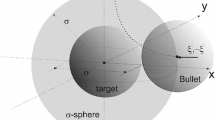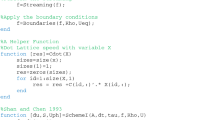Abstract
A spurious current is a small-amplitude artificial velocity field which arises from an imbalance between discretized forces in multiphase/multi-component flows. If it occurs, the velocity field may persist indefinitely, preventing the achievement of a true equilibrium state. Spurious velocities can sometimes be as large as the characteristic velocities of the problem, causing severe instability and ambiguity between physical and spurious velocities. They are typically exacerbated by large values of numerical surface tension or when the two fluids being simulated have large density ratios. The resulting instability can restrict what parameters may be simulated. To varying degrees, spurious currents are found in all multiphase flow models of the lattice Boltzmann method (LBM). There have been many studies of the occurrence of the phenomenon, and many suggestions on how to eliminate it. This paper reviews the three main models of simulating multiphase/multi-component flow in the lattice Boltzmann method, as well as the subsequent modifications made in order to reduce or eliminate spurious currents.
Similar content being viewed by others
References
J. S. Rowlinson and B. Widom, Molecular Theory of Capillarity, Oxford Univ. Press, Oxford, UK (1982).
S. Chen and G. D. Doolen, Lattice Boltzmann method for fluid flows, Annu. Rev. Fluid Mech., 30 (1998) 329–364.
A. K. Gunstensen, D. K. Rothman, S. Zaleski and G. Zanetti, Lattice Boltzmann model of immiscible fluids, Phys. Rev. A, 43(8) (1991) 4320–4327.
X. Shan and H. Chen, Lattice Boltzmann model for simulating flows with multiple phases and components, Phys. Rev. E, 47(3) (1993) 1815–1820.
X. Shan and H. Chen, Simulation of nonideal gases and liquid-gas phase transitions by the lattice Boltzmann equation, Phys. Rev. E, 49(4) (1994) 2941–2948.
M. R. Swift, W. R. Osborn and J. M. Yeomans, Lattice Boltzmann simulation of nonideal fluids, Phys. Rev. Let., 75(5) (1995) 830–833.
M. R. Swift, E. Orlandini, W. R. Osborn and J. M. Yeomans, Lattice Boltzmann simulations of liquid-gas and binary fluid systems, Phys. Rev. E, 54(5) (1996) 5041–5052.
I. Halliday, S. P. Thompson and C. M. Care, Macroscopic surface tension in a lattice Bhatnagar-Gross-Krook model of two immiscible fluids, Phys. Rev. E, 57(1) (1998) 514–523.
S. P. Thompson, I. Halliday and C. M. Care, Mesoscopic hydrodynamics of diphasic lattice Bhatnagar Gross Krook fluid interfaces, Phys. Chem. Chem. Phys., 1 (1999) 2183–2190. 2190.
S. V. Lishchuk, C. M. Care and I. Halliday, Lattice Boltzmann algorithm for surface tension with greatly reduced microcurrents, Phys. Rev. E, 67(036701) (2003) 1–5.
X. Shan and G. Doolen, Multi-component lattice-Boltzmann model with interparticle interaction, J. Stat. Phys., 81(1–2) (1995) 379–393.
P. Yuan and L. Shaefer, Equations of state in a lattice Boltzmann model, Phys. Fluids, 18(042101) (2006) 1–11.
X. Shan, Analysis and reduction of the spurious current in a class of multiphase lattice Boltzmann models, Phys. Rev. E, 73(047701) (2006) 1–4.
Q. Kang, D. Zhang and S. Chen, Displacement of a two-dimensional immiscible droplet in a channel, Phys. Fluids, 14(9) (2002) 3203–3214.
N. Martys and H. Chen, Simulation of multicomponent fluids in complex three-dimensional geometries by the lattice Boltzmann method, Phys. Rev. E, 53(1) (1996) 743–750.
M. Sbragaglia, R. Benzi, L. Biferale, S. Succi, K. Sugiyama and F. Toschi, Generalized lattice Boltzmann method with multirange pseudopotential, Phys. Rev. E, 75(026702) (2007) 1–13.
G. Falcucci, G. Bella, G. Chiatti, S. Chibbaro, M. Sbragaglia and S. Succi, Lattice Boltzmann models with midrange interactions, Commun. Comput. Phys., 2(6) (2007) 1071–1084.
G. Falcucci, S. Ubertini and S. Succi, Lattice Boltzmann simulations of phase-separating flows at large density ratios: the case of doubly attractive pseudo-potentials, Soft Matter, 6 (2010) 4357–4365.
T. Inamuro, N. Konishi and F. Ogino, A Galilean invariant model of the lattice Boltzmann method for multiphase fluid flows using free-energy approach, Comput. Phys. Commun., 129 (2000) 32–45.
T. Seta and K. Okui, Effects of truncation error of derivative approximation for two-phase lattice Boltzmann method, J. Fluid Sci. Tech., 2(1) (2007) 139–151.
R. R. Nourgaliev, T. N. Dinh and B. R. Sehgal, On lattice Boltzmann modeling of phase transition in an isothermal non-ideal fluid, Nuclear Eng. Design, 211 (2002) 153–171.
A. Cristea and V. Sofonea, Reduction of spurious velocity in finite difference lattice Boltzmann models for liquid-vapor systems, Int. J. Mod. Phys. C, 14(9) 1251–1266.
C. M. Pooley and K. Furtado, Eliminating spurious velocities in the free-energy lattice Boltzmann method, Phys. Rev. E, 77(046702) (2008) 1–9.
X. He, S. Chen and R. Zhang, A lattice Boltzmann scheme for incompressible multiphase flow and its application in simulation of Rayleigh-Taylor instability, J. Comput. Phys., 152 (1999) 642–663.
X. He, X. Shan and G. D. Doolen, Discrete Boltzmann equation for nonideal gasses, Phys. Rev. E, 57(1) (1998) R13–R16.
A. J. Wagner, The origin of spurious velocities in lattice Boltzmann, Int. J. Mod. Phys. B, 17(1–2) (2003) 193–196.
T. Lee and C. L. Lin, A stable discretization of the lattice Boltzmann equation for simulation of incompressible twophase flows at high density ratio, J. Comput. Phys., 206 (2005) 16–47.
T. Lee and P. F. Fischer, Eliminating parasitic currents in the lattice Boltzmann equation method for nonideal gasses, Phys. Rev. E, 74(046709) (2006) 1–7.
D. Jamet, D. Torres and J. U. Brackbill, On the theory and computation of surface tension: The elimination of parasitic currents through energy conservation in the second gradient method, J. Comput. Phys., 182 (2002) 262–276.
D. Chiappini, G. Bella, S. Succi, F. Toschi and S. Ubertini, Improved lattice Boltzmann without parasitic currents for Rayleigh-Taylor instability, Commun. Comput. Phys., 7 (2010) 423–444.
Z. Guo, C. Zheng and B. Shi, Force imbalance in lattice Boltzmann equation for two-phase flows, Phys. Rev. E, 83(036707) (2011) 1–8.
T. Lee, Effects of incompressibility on the elimination of parasitic currents in the lattice Boltzmann equation method for binary fluids, Comput. Math. App., 58 (2009) 987–994.
Author information
Authors and Affiliations
Corresponding author
Additional information
Kevin Connington is currently a postdoctoral research associate at the Levich Institute for Physico-Chemical Hydrodynamics at the City College of the City University of New York. He received a Ph.D in Mechanical Engineering from The Johns Hopkins University in 2009. He also spent two years as a visiting scholar in the Earth and Environmental Sciences (EES) division at Los Alamos National Laboratory.
Taehun Lee obtained his B.S. and M.S. degrees from the Department of Mechanical Engineering, Seoul National University, Korea, in 1996 and 1998, respectively. He received his Ph.D from the University of Iowa in 2004. Dr. Lee is currently associate professor of Mechanical Engineering, City College of City University of New York, USA. His research interests include lattice Boltzmann method, multiphase flow modeling, and boiling heat transfer.
Rights and permissions
About this article
Cite this article
Connington, K., Lee, T. A review of spurious currents in the lattice Boltzmann method for multiphase flows. J Mech Sci Technol 26, 3857–3863 (2012). https://doi.org/10.1007/s12206-012-1011-5
Received:
Revised:
Accepted:
Published:
Issue Date:
DOI: https://doi.org/10.1007/s12206-012-1011-5




